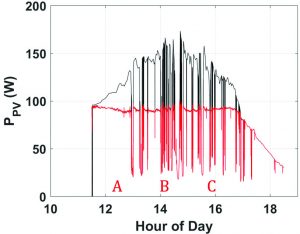A Reliable Set-Point Tracking Algorithm to Extend the Utility of Solar Arrays
Jason Galtieri with adviser P. Krein
Maximum power point (MPP) tracking is the standard control scheme for photovoltaic (PV) arrays of all sizes. Inverter tracking algorithms work on second to sub-second time scales and can track most naturally occurring irradiance changes, such as moving cloud coverage. Fast response tracking imposes large power swings on the grid, which must be absorbed in spinning reverses. As PV penetration increases and replaces traditional spinning generation, there is concern the grid’s voltage and frequency stability could be compromised.
For practical scenarios, MPPT maximizes the variability a PV array imposes on the grid and minimizes the amount of control provided to the array operator and/or utility.

b) Sky images throughout day
Figure 1: Outdoor results for RCC boost converter with set-point algorithm
The MPP is determined entirely by the amount of available irradiance, which can be difficult or error-prone to forecast ahead. To date, active array control has mainly taken the form of curtailment during periods of overproduction, but these methods are relatively slow and limited. In our work, off-MPP set-point strategies are proposed which use ripple correlation control to quickly find the MPP current and voltage. The algorithm is implemented onto a dc-dc boost converter and tested with a 185 W commercial panel. Full-day outdoor results are shown in Figure 1. The red line is the panel’s measured output following the set-point algorithm and the black is the MPP throughout the day. The converter tracks a constant power output despite the relatively cloudy day. Variability from the set point is a fraction of the MPP variability. Some energy is lost when following the set point, but the variability trade-off is larger than the energy loss. As such, the set point is economically competitive in a system with both variability costs and energy production. This research is supported by the Grainger Center for Electric Machinery and Electromechanics.
